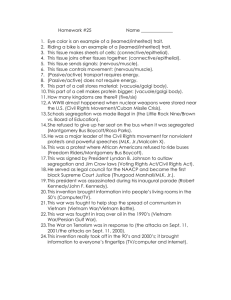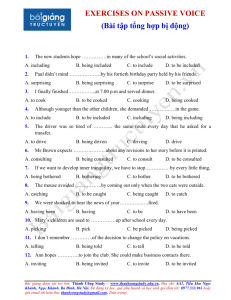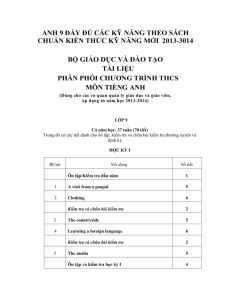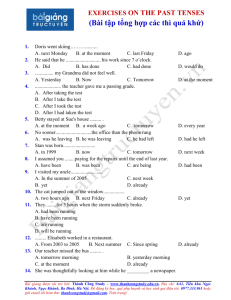ELT in Vietnam general and tertiary education
advertisement
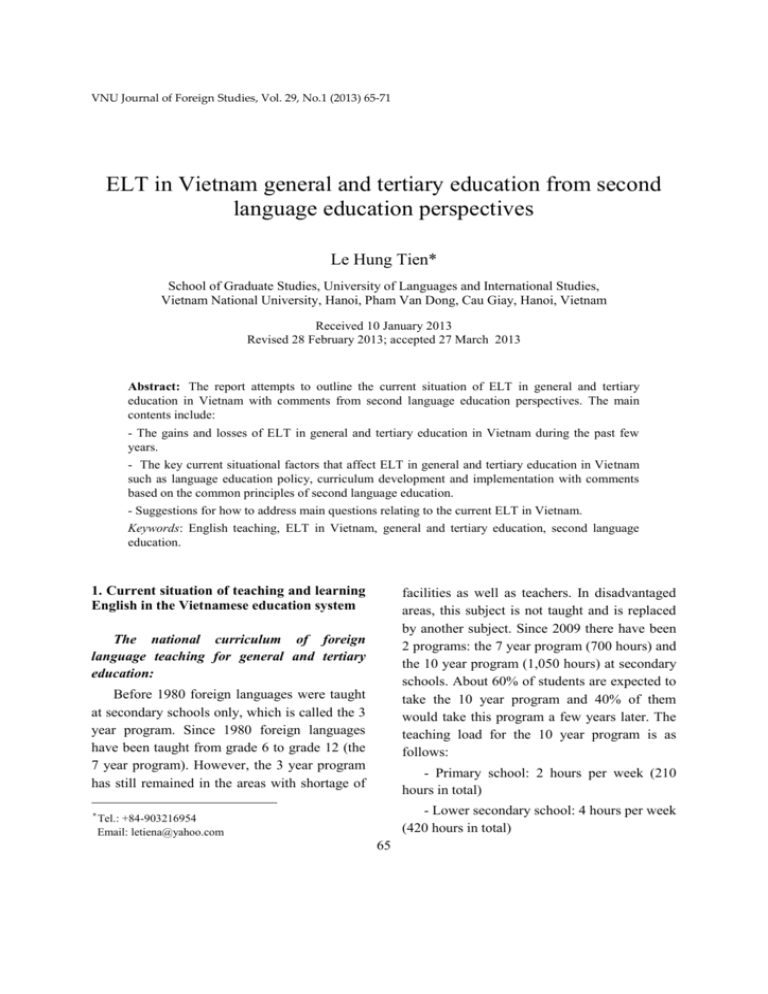
VNU Journal of Foreign Studies, Vol. 29, No.1 (2013) 65-71 ELT in Vietnam general and tertiary education from second language education perspectives Le Hung Tien* School of Graduate Studies, University of Languages and International Studies, Vietnam National University, Hanoi, Pham Van Dong, Cau Giay, Hanoi, Vietnam Received 10 January 2013 Revised 28 February 2013; accepted 27 March 2013 Abstract: The report attempts to outline the current situation of ELT in general and tertiary education in Vietnam with comments from second language education perspectives. The main contents include: - The gains and losses of ELT in general and tertiary education in Vietnam during the past few years. - The key current situational factors that affect ELT in general and tertiary education in Vietnam such as language education policy, curriculum development and implementation with comments based on the common principles of second language education. - Suggestions for how to address main questions relating to the current ELT in Vietnam. Keywords: English teaching, ELT in Vietnam, general and tertiary education, second language education. 1. Current situation of teaching and learning English in the Vietnamese education system* facilities as well as teachers. In disadvantaged areas, this subject is not taught and is replaced by another subject. Since 2009 there have been 2 programs: the 7 year program (700 hours) and the 10 year program (1,050 hours) at secondary schools. About 60% of students are expected to take the 10 year program and 40% of them would take this program a few years later. The teaching load for the 10 year program is as follows: The national curriculum of foreign language teaching for general and tertiary education: Before 1980 foreign languages were taught at secondary schools only, which is called the 3 year program. Since 1980 foreign languages have been taught from grade 6 to grade 12 (the 7 year program). However, the 3 year program has still remained in the areas with shortage of - Primary school: 2 hours per week (210 hours in total) - Lower secondary school: 4 hours per week (420 hours in total) *Tel.: +84-903216954 Email: letiena@yahoo.com 65 66 L.H. Tien / VNU Journal of Foreign Studies, Vol. 29, No. 1 (2013) 65-71 - Secondary school: 4 hours per week (420 hours in total) It is expected that the 7 year program would cover all areas in 2010 and the 10 years program would be applied to the whole Vietnam in 2019. Apart from the above compulsory program for the lower secondary and secondary schools, recently a pilot program has been implemented at primary level from grade 3 to grade 5 in some big cities as an optional subject, ie. English as an elective or strengthening subject in these classes. At tertiary level the regular program for foreign languages, as determined by the Ministry of Education and Training (MOET) is 240 hours for general English and from 60 to 90 hours for English for Specific Purposes (ESP). Results: According to Van et al. (2006), the quality of teaching and learning foreign languages at both general and tertiary levels in Vietnam is still very low, which is far from meeting the demand of socio-economic development of the country at the moment. The evidence of this low quality at general level is the students’ poor vocabulary and grammar, incorrect pronunciation, understandard listening and speaking skills. At tertiary level the teaching and learning are of similar quality: students’ language proficiency is very low and many college graduates do not meet the foreign language requirement of the recruiters. After 4 years of learning English in the lower secondary school the language proficiency of students is just limited within some basic tasks such as introducing oneself, describing some simple objects in the house etc. Though the aims of the curriculum for this level are to train the 4 skills and to set up the foundation for the improvement and strengthening of these skills at higher level (secondary school) and their required language proficiency is intermediate level. Then students continue learning English for 3 years in the secondary school with an aim to reach upperintermediate level. However their real level is just somewhere between elementary and lowerintermediate. Many school leavers cannot read simple texts in English nor communicate with English speaking people in some most common cases. Within disadvantaged areas where students have to take the 3 year program only the result is, of course, much worse. Actually the real focus of teaching and learning English in both lower secondary and secondary schools is completing English grammar and vocabulary exercises, in order to pass the final exams (even the entrance exams of many universities and colleges in Vietnam) which maily consist of grammar and vocabulary tasks only. At the university the start-up levels of the students are much different. According to the surveys conducted by five key universities in 2005 (Van, 2010) the real level of the marjority of students is just elementary. Therefore many univerities have to seek to the language program for beginner (or false beginner) learners. As a result, after 240 hours of general English the college students’ level is lowerintermediate. Then with from 60 to 90 hours of ESP at senior years their real level of English cannot be significantly improved and is still very far from the requirements of their future jobs. Identification of main causes: General education: L.H. Tien / VNU Journal of Foreign Studies, Vol. 29, No. 1 (2013) 65-71 Curriculum: In spite of much improvement made to the foreign language training curriculum it is still beyond the reach of a marjority of students at general school, especially those from rural or disadvantaged areas. Apart from that, the school curriculum is overburdensome to both teachers and students: students have to do lots of subjects at school and the time for foreign languages is very limited. Teachers: The quality of teachers in many areas is a real problem. Many of the teachers had got deficit training in the past and currently the chance of retraining for them is limited. Teaching methods: the widely accepted method is traditional which focuses on the teaching of grammar rules with a heavy load of grammar exercises and reading, rote learning of sentence patterns and vocabulary. The lessons are mainly teacher-dominated with grammarcentred content to meet the demand of the grammar-based exams. Facilities: The classrooms in a majority of schools are substandard with insufficient facilities for language teaching. Testing and assessment: Still testing and assessment do not implement their role of directing learning and teaching of language skills. As testing focuses only on checking language knowledge rather than language skills, the teaching and learning heavily emphasize on grammar and writing. Tertiary education: Research studies in Vietnam (Huong, 2008; Van, 2010; Nga, 2007) show that ELT at tertiary level has been suffering from serious problems such as deficit time and intensity, the start-up English level of students, assessment criteria and the motivation of learners, hence the poor results as stated above. 67 Solutions: In recent years a series of conferences and seminars at various levels have been organized with an aim to work out solutions to foreign language education in Vietnam. The most remarkable evidence of change is the issue of the Decision 1400-QD-TTg by the Prime Minister approving the Project of foreign language teaching and learning in the national system for the 2008-2020 period. Within the context of this Decision, The Ministry of Education and Training has issued the Common Framework of Levels of Foreign Language Proficiency, based on the Common European Framework of Reference for Languages: Learning, Teaching, and Assessment (CEFR). This Framework includes 6 levels equivalent to those of CEFR and the national foreign language education curriculum will be designed accordingly. The greatest change in the foreign language education in Vietnam can be seen in the introduction of English into the primary education curriculum starting from grade 3. The new curriculum defines that students at the completion of Primary education should reach Level 1 (A1 of CEFR), at the completion of Lower secondary education Level 2 (A2 CEFR) and General school leavers should reach Level 3 (B1 CEFR). The teaching of second foreign language would be introduced into curricula from grade 6 to grade 12 and the expected level for general school leavers is 2. The teaching of some subjects (mathematics, physics, chemistry and others) in English would be implemented where appropriate (starting from high schools in big cities first). For tertiaty education, graduates from vocational colleges should reach level 2 and university graduates level 3, and graduates from language colleges should reach from level 4 to 68 L.H. Tien / VNU Journal of Foreign Studies, Vol. 29, No. 1 (2013) 65-71 5, with the second foreign language as a compulsory subject. The Project targets a remarkable advance in the improvement of the foreign language proficiency for the Vietnamese human resource during the period from now to 2020: the graduates from vocational colleges and universities would be proficient users of foreign languages, which would be an advantage of the Vietnamese workforce. 2. Comments and recommendations The current situations and the solutions for improvement of foreign language teaching and learning in general and ELT in particular in Vietnam need a thorough analysis before any final conclusions are made. However a quick look at the issue may leave some reservations for EFL teachers in Vietnam. The policy for foreign language education in the national education system: As mentioned above, the greatest change in the foreign language education in Vietnam in the time ahead can be seen in the introduction of English into the primary education curriculum starting from grade 3. This seems to be an overemphasis on the factor of age in foreign language education (‘the earlier the better’), hence overlooking at other factors. Many research studies in second language acquisition show that there is hardly any obvious evidence for this emphasis, or at least the age factor should be placed among other factors affecting L2 learning when the starting age is considered/taken into consideration. The study conducted by Snow and Hoefnagel-Hohle (1978) comparing three groups of L2 learners (child, adolescent and adult learners, ) shows that the adolescent always outrun the other groups and in the first year the adult group outran the child learner group, in the second year these groups have an equal level. Studies by Patkowski (1980) and Johnson and Newport (1989) show that child learners only have an advantage over older learners in acquiring the native-like pronunciation. However as Lightbown and Spada (2000) point out, native-like pronunciation or proficiency is not a priorized target in L2 learning at school. Many researchers think that age factors should be considered in close relationship with other factors like motivation, personality, socioeconomic and learning conditions and so on. According to Lightbown and Spada (2000) where the language of instruction at school is the mother tongue it is better to teach foreign languages at a later age (10-12), because with only 2-3 hours of L2 learning per week at school it is impossible for the children to reach native-like level and therefore their advantage mentioned above will be lost. The early learners (aged 3-7) may easily loose the learning motivation if they then learn together with other children who start later and after one year they both have the same level. Therefore Lightbown and Spada (2000:61) conclude: “In educational research it has been reported that learners who began learning a second language at the primary school did not fare better in the long run than those who began in early adolescence” Therefore the 10 year program for foreign language education at general school starting at grade 3 may not be the optimal remedy for language education in Vietnam at the moment when our resources are still limited. If will be better if the resourses are invested into a shorter period (7 year program) to enhance the quality of learning and teaching, instead of extending to L.H. Tien / VNU Journal of Foreign Studies, Vol. 29, No. 1 (2013) 65-71 10 years with shortage of qualified teachers, appropriate facilities and other resources. Learning conditions and the Vietnamese learner: Studies in second language learning show that to ensure the success in teaching and learning a second language a number of factors should be taken into consideration, among which intelligence, aptitude, personality, motivation and aptitudes, beliefs are the most important. These factors should be investigated carefully in the Vietnamese learners together with factors relating to learning and teaching conditions. This issue has not been adequately addressed in curriculum designing, teaching material development as well as the development of appropriate teaching methods for our ELT classes. The main reason is that we lack research studies on the Vietnamese learners relating to these factors and the principles from the outside (especially those developed for Western settings) are being applied to Vietnamese ELT classrooms, from the curriculum designing to coursebook writing and assessment. The Common Framework of Levels of Foreign Language Proficiency, based on the Common European Framework of Reference for Languages: Learning, Teaching, Assessment (CEFR) may be an ideal framework in other countries where the socioeconomic conditions are much better and therefore, more favourable for L2 teaching and learning as compared to Vietnam. Whether or not this Framework is applicable and feasible to Vietnamese general schools still remains a big question for ELT researchers and teachers in Vietnam. The reason is that the learning conditions, target language environment, the ability as well as the learning habits of the learners, their beliefs and motivation and so on are still far different from those of the learners 69 in better developed countries, and these gaps will not be easily bridged in just a few years ahead, as expected by the Project for 2020. The Framework may be a good target for FLT in Vietnam in the long run. Teachers training: According to More (2007:5) teaching is: “the actions of someone who is trying to assist others to reach their fullest potentials in all aspects of development.” To be able to complete this difficult task a language teacher should get sufficient training at the beginning of their teaching career, retraining and selfprofessional development throughout their professional practice process, as suggested by Richards (2002:25) with basic principles of three concepts in teaching and what teachers shoud do throughout their career development. Therefore, the training of language teachers is not merely the task of trainers at teacher training colleges, which provides the basic training for teachers, but this must be a long process of training, retraining and also selflearning throughout their teaching life. To train sufficient teaching staff for the 2020 Project in terms of number and ability, there must be a great improvement in the training programs as well as the adequate enormous facilities. Recommendations: Our recommendations below are based on the above analyses and our own experience as EFL teachers in Vietnam. - There should be an adequate investment into the research projects on the issues mentioned above for feasible solutions for the current ELT in Vietnam, with a focus on the feasibility of the 2020 Project. - Reconsidering carefully the real resources of our education sector for the priotized investment into foreign language education to 70 L.H. Tien / VNU Journal of Foreign Studies, Vol. 29, No. 1 (2013) 65-71 work out appropriate policies, targets and roadmap for the development of foreign language education in Vietnam to ensure the successful implementation of the Project and avoid the resources waste as in some previous education reform projects. - The improvement of the new foreign language education curriculum, developing new textbooks, training and retraining of teachers, desinging the national English test and developing appropriate facilities for language teaching at school should be based on rigorous research studies of the Vietnamese contexts conducted by both researchers and teachers from inside and outside of Vietnam to ensure that the local solutions for foreign language education are based on global thinking. References [1] Ellis, R. (2002). Principles of instructed language teaching. Asian EFL Journal. Special edition: May 2005 Conference Proceedings. [2] Tô Thị Thu Hương (2008). Sinh viên Việt Nam học tiếng Anh như thế nào? Tạp chí Ngôn ngữ và đời sống, số 6 (152), 20-27. [3] Johnson, J. and Newport, E. (1989). Critical period effects in the second language learning: The influenceof maturational state on the acquisition of English as a second language. Cognitive Psychology 21, 60-99. [4] Lightbown, P.M. & Spada, N. (2000). How Languages are Learned. Oxford: Oxford University Press. [5] Moore, K.D. (2007). Classroom Teaching Skills. Boston: McGrow Hill. [6] Trần Thị Nga (2007). Dạy ngoai ngữ ở trường Đại học Khoa học Tự nhiên. Journal of Science, Vietnam National University, Vol. 23, 149-155. [7] Patkowski, M. (1980). The sensitive period for the acquisition of syntax in a second language. Language Learning 30/2 , 449-472 [8] Richards, J.C. (2002). Theories of Teaching in Language Teaching, in Richarts, J.C. & Renandya, W.A., (eds.), Methodology in Language Teaching- An Anthology of Current Practice. Cambridge: Cambridge University Press. [9] Snow, C. and Hoefnagel-Hohle, M. (1978). The Critical period for language acquisition: evidence from second language learning. Child Development 49/4, 1114-1128. [10] Hoàng Văn Vân, Nguyễn Thị Chi, Hoàng Thị Xuân Hoa (2006). Đổi mới phương pháp giảng dạy tiếng Anh ở trường trung học phổ thông Việt Nam. Hà Nội: NXB Giáo dục. [11] Hoàng Văn Vân (2010). Dạy tiếng Anh không chuyên ở các trường đại học Việt Nam, những vấn đề lý luận và thực tiễn. Hà Nội: NXB Đại học Quốc gia Hà Nội. Dạy tiếng Anh ở bậc phổ thông và đại học Việt Nam nhìn từ khoa học giáo dục ngoại ngữ Lê Hùng Tiến Khoa Sau Đại học, Trường Đại học Ngoại ngữ, Đại học Quốc gia Hà Nội, Đường Phạm Văn Đồng, Cầu Giấy, Hà Nội, Việt Nam Tóm tắt: Bài viết điểm lại những nét chính về hiện trạng dạy tiếng Anh ở bậc phổ thông và đại học Việt Nam và đưa ra một số nhận xét theo cách nhìn của các nhà lý luận giáo dục ngoại ngữ. Phần đầu bài viết điểm qua những thành tựu và tồn tại của việc dạy tiếng Anh ở bậc phổ thông và đại học L.H. Tien / VNU Journal of Foreign Studies, Vol. 29, No. 1 (2013) 65-71 71 Việt Nam trong những năm qua. Trong phần tiếp theo, bài viết phân tích những nhân tố chính tác động đến việc dạy tiếng Anh ở bậc phổ thông và đại học Việt Nam như chính sách giáo dục ngôn ngữ, phát triển và thực hiện chương trình giáo dục ngoại ngữ quốc gia, trình độ và kỹ năng đội ngũ giáo viên v.v. Từ đó, bài viết đưa ra một số nhận xét và phân tích dựa trên ý kiến của các nhà lý luận giáo dục ngoại ngữ cùng những gợi ý cho việc giải quyết một số vấn đề liên quan đến dạy tiếng Anh ở bậc phổ thông và đại học Việt Nam. Từ khoá: dạy tiếng Anh ở Việt Nam, giáo dục phổ thông và đại học, giáo dục ngoại ngữ.




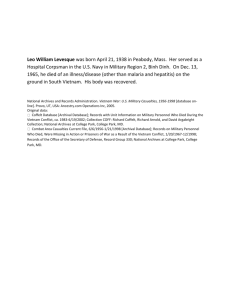


![vietnam[1].](http://s2.studylib.net/store/data/005329784_1-42b2e9fc4f7c73463c31fd4de82c4fa3-300x300.png)
